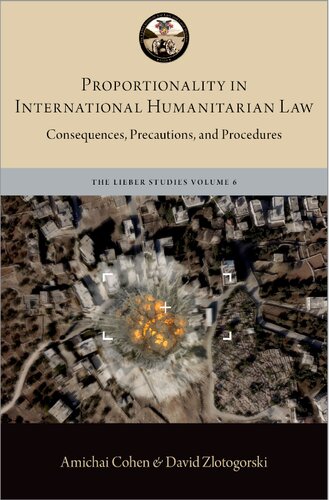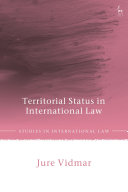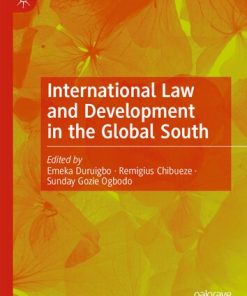(EBOOK PDF)Proportionality in International Humanitarian Law Consequences Precautions and Procedures 1st edition by Amichai Cohen, David Zlotogorski 9780197556740 0197556744 full chapters
$50.00 Original price was: $50.00.$25.00Current price is: $25.00.
Proportionality in International Humanitarian Law Consequences Precautions and Procedures 1st edition by Amichai Cohen, David Zlotogorski – Ebook PDF Instant Download/Delivery: 9780197556740, 0197556744
Full download Proportionality in International Humanitarian Law Consequences Precautions and Procedures 1st edition after payment
Product details:
• ISBN 10:0197556744
• ISBN 13:9780197556740
• Author:Amichai Cohen, David Zlotogorski
Proportionality in International Humanitarian Law
Consequences, Precautions, and Procedures
The principle of proportionality is one of the corner-stones of international humanitarian law. Almost all states involved in armed conflicts recognize that launching an attack which may cause incidental harm to civilians that exceeds the direct military advantage anticipated from the attack is prohibited. This prohibition is included in military manuals, taught in professional courses, and accepted as almost axiomatic. And yet, the exact meaning of the principle is vague. Almost every issue, from the most elementary question of how to compare civilian harm and military advantage, to the obligation to employ accurate but expensive weapons, is disputed. Controversy is especially rife regarding asymmetrical conflicts, in which many modern democracies are involved. How exactly should proportionality be implemented when the enemy is not an army, but a non-state-actor embedded within a civilian population? What does it mean to use precautions in attack, when almost every attack is directed at objects that are used for both military and civilian purposes?In Proportionality in International Humanitarian Law, Amichai Cohen and David Zlotogorski discuss the philosophical and political background of the principle of proportionality. Offering a fresh and comprehensive look at this key doctrine, they comprehensively discuss the different components of the proportionality “equation” – the meaning of “incidental harm” to civilians; the “military advantage” and the term “excessive”. The book proposes the debates over the principle of proportionality be reframed to focus on the precautions taken before the attack along with the course States should follow in investigations of the violations of the principle.
Proportionality in International Humanitarian Law Consequences Precautions and Procedures 1st Table of contents:
Table of Treaties and Cases
Part I: General Concepts
1. An Introduction to Proportionality
A. General Concepts
B. Legal Sources
C. The Structure of the Book
2. Ethical and Constitutional Foundations
A. The Possible Sources for Proportionality
B. A Philosophical and Religious Prism of Proportionality
Premodern Views of Proportionality
The Philosophical Background
C. The Rational Analysis of Proportionality
Rational Reciprocal Explanation
D. Proportionality as a Mode of Control
E. The Constitutional and Administrative Background to Proportionality Analysis
3. A General Overview of Proportionality in IHL
A. The History and Development of IHL Proportionality
B. Contemporary IHL and Proportionality
C. The Changing Nature of Armed Conflict and Proportionality
Applying Proportionality: Examples and Dilemmas
Fighting NSAs and the Application of the Principle of Proportionality
Parallel Application of IHL and International Human Rights Law
The Right to Life during Armed Conflicts
Different Balances of IHL/HRL in Different Types of Armed Conflicts?
D. Conclusion
Part II: The Practical Application of Proportionality
4. Military Advantage
A. What Constitutes a Military Advantage?
B. Military Advantage of an Attack
5. Incidental Harm and the Analysis of Proportionality
A. Civilians or All Persons Protected from Attack
B. What Constitutes Harm?
Harm to the Person
Economic Damage
Civilian Objects
Damage to the Natural Environment
Benefitting from Proportional Harm
C. Indirect and Reverberating Effects
Foreseeable Harm
Causality
D. The Level of Expectation/Anticipation
E. A Balancing Act: What Constitutes a Violation?
Different Standards in Different Conflicts?
Excessive vs. Extensive: An Upper Limit to Civilian Harm?
F. From Whose Perspective Should Proportionality Be Examined?
6. Soldiers vs. Civilians
A. The Basic Dilemma
B. The Kasher vs. Walzer Debate
C. The Lives of Soldiers and Proportionality
D. The Context of Force Protection
E. The Enemy’s Soldiers
7. Strategic and Cultural Considerations
A. The Meaning of “Concrete and Direct Military Advantage”
B. Policy Arguments Regarding Strategic and Cultural Considerations
The Divide between IHL and Laws on the Use of Force
An Inherent or Tangible Military Advantage?
Uncertainty and Manipulations
C. Who Bears the Burden of Accommodating a State’s Sensitivities?
A Matter of Context?
Permitting Less Collateral Damage?
D. Different Requirements for Different States?
E. The Futility of Force, Deterrence, and Proportionality
8. Direct Participation in Hostilities and Its Effect on Proportionality
A. The Concept of Direct Participation in Hostilities
B. The Definition of Direct Participation in Hostilities
9. Human Shields and Proportionality
A. The Problem of Human Shields
B. Involuntary Human Shields
C. Voluntary Human Shields
D. Discerning Choice
10. The Principle of Distinction and Its Relation to Proportionality
A. The Definition of Military Objectives and Its Relation to Proportionality
B. Indiscriminate Attacks
Protection of Cultural Property
Part III: Understanding Proportionality
11. The Vagueness of Proportionality
A. Experimental Meanings of Proportionality
B. The Formula of Proportionality
C. Rules of Thumb
D. Inherent Vagueness?
12. Procedural Aspects of Proportionality
A. The Legal Background
B. Procedures
C. The Suitable Decision-Maker
Doubts
D. How Much Intelligence Is Necessary?
E. Warnings
Roof Knocking
F. What Is the Role of Military Legal Advisors?
G. Conclusion
Creating a Zone of Reasonableness
Responsibility and Control
Organization and Culture
13. Judicial Review and Investigations
A. Introduction
B. Ex Ante Review
C. Ex Post Review: The Problem with the Criminal Approach
Criminal Investigations
The Problem with Criminal Investigations
Should Criminal Prosecutions Be Forsaken?
D. Ex Post Assessment: An Alternative to Criminal Trials
The Non-Exclusive Nature of the Grave Breaches Regime under IHL
E. The Saleh Shehadeh Targeted Killing
14. The Future of Proportionality
A. On the Future of Proportionality
Image-Fare
Cyber Warfare and Proportionality
Autonomous Weapons and Proportionality
Conclusion—A Way Forward?
Bibliography
Index
People also search for Proportionality in International Humanitarian Law Consequences Precautions and Procedures 1st:
from the ashes
remnant from the ashes
phoenix rising from the ashes
rise from the ashes
x men from the ashes
Tags:
Proportionality,International Humanitarian Law,Amichai Cohen, David Zlotogorski
You may also like…
Jurisprudence & Law
International Law of Taxation (Elements of International Law) Peter Hongler 9780192653901 0192653903
Politics & Philosophy - Social Sciences
Appropriating Hobbes: Legacies in Political, Legal, and International Thought
Business & Economics - Investing
Custom and its Interpretation in International Investment Law: Volume 2
Uncategorized
The Early Books of Yehuda Amichai 1st edition by Yehuda Amichai 0935296751 978-0935296754
Computers - Computer Business & Culture
Cryptocurrencies in Public and Private Law David Fox (Editor)
History - American Studies
The American Pageant AP 17th Edition David M. Kennedy And Lizabeth Cohen
Jurisprudence & Law - Foreign & International Law
Language and Legal Interpretation in International Law Anne Lise Kjaer











